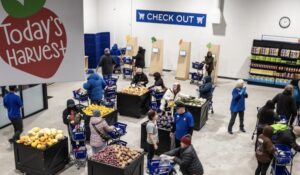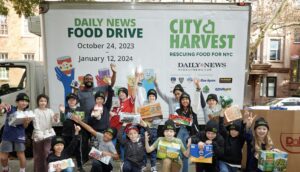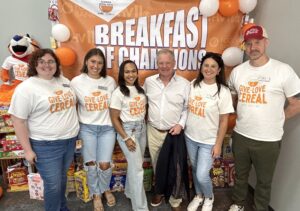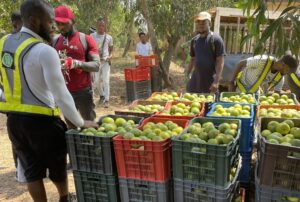Two years in the making, Second Harvest Inland Northwest recently unveiled an initiative aimed at sourcing way more food, while ensuring absolutely none of it goes to waste. The name of the program underscores its goal: Zilch, as in zero waste.
The two-part program involves getting more food into the warehouse, while also distributing it quickly before its quality becomes compromised. In both aspects of the program, building new relationships was key.
The program largely grew out of Second Harvest Inland’s strategy of relying heavily on donated food. It purchases less than 10% of the food it distributes, unlike a growing number of food banks that are doing more purchasing. Zilch addresses a major challenge of donated food, which is that unknown amounts of it – sometimes very large amounts – can show up in the warehouse with little warning.
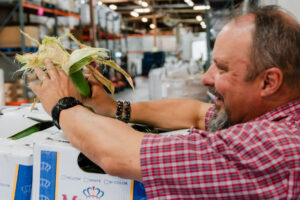
Zilch embraces this uncertainty of donated food. “It’s a branded program that is really off to the races,” said Tony Cook, Project Lead.
In the exacting world of retail grocery, bananas may be a bit too green, or lettuce leaves too curled, making them unacceptable for sale, but still perfectly good to eat. That’s where Part 1 of Zilch comes in, which calls for Second Harvest Inland Northwest to develop relationships in the food shipping business to ensure the food bank is top of mind whenever a truckload of food does not meet up with strict requirements.
The food bank used business cards (“Don’t dump, donate!”) to spread the word among truckers, distributors, and especially dispatchers who typically act as problem solvers when food is undeliverable. Aiding the effort is the fact that Second Harvest Inland Northwest is conveniently located between two major highways, making it far easier for trucks to drop food off at one of its two warehouses versus drive to a landfill and pay the costs of offloading the truck. “Instead they back that truck up and we can have it offloaded in 20 minutes,” Cook said. “They get a receipt for the product and they can write it off.”
Second Harvest Inland Northwest’s concerted effort has resulted in it receiving multiple additional truckloads of food every week. The food is fresh (60% of what the food bank distributes overall is fresh), comes in wide variety, and is of exceptional quality. Noted Cook, “It’s an embarrassment of riches when it comes to Zilch on that side.”
Part 2 of Zilch has to do with making sure the food finds a home quickly. The food bank uses the USDA’s FoodKeeper App, along with its own judgment, to prioritize food that likely won’t maintain retail quality past seven days. At the end of the week, that food gets “Zilched,” Cook said, adding “Zilch is a verb here.”
To Zilch is to deploy a team of 20 volunteers working in teams of two and three to load up Sprinter vans to deliver the fresh food. The volunteers fan out every Thursday and Friday, making stops at subsidized senior housing facilities, as well as two refugee communities. Importantly, these distribution points are locations the food bank had not previously served.
Since December 2023, the food bank has made available through Zilch more than 337,000 pounds of food that otherwise was at risk of going to waste. While that’s a small percentage of the food bank’s total distribution, it’s a big deal for those who did not previously have access to the food. “That inbound food is such an important part to our ability to serve more in the community,” Cook noted.
The food bank has also taken care to get clients involved in the distributions, giving them ownership in the process. “It becomes a community event,” Cook said. “We’re doing food with them instead of to them.”
Unlike some of the food bank’s other programs, Zilch is highly unscripted. Mobile markets, for example, require a certain amount and type of food, but with Zilch, anything goes. “The commitment is that we’re going to do everything we can to bring food every week, but we promise that it will be different every week,” Cook said.
Going off script is in keeping with the need to innovate to meet the persistently high need for food in the current environment. “We can’t be normal anymore,” Cook said. “We need to be creative and we need to be willing to take some risks.” – Chris Costanzo
Food Rescuers Continue to Innovate
With Feeding America setting a goal to rescue one billion additional pounds of food annually, it’s fitting to recognize some of the assists that are available to food banks seeking to do more rescue.
Move For Hunger, a national nonprofit that started out by helping people donate their food when they move, now offers a program that transports fresh food from donors to food banks. The Fresh Food Program takes advantage of Move For Hunger’s network of more than 1,200 partners in the trucking and logistics industries to get large amounts of food from farms and other sources to communities in need. (Food Bank News first wrote about the program here.)
“We are just focusing on the transportation piece,” said Stephanie De La Hoz, Director of Programming. “We never charge the people donating the food, and we never charge the people receiving the food.”
More recently, Move For Hunger also started a program to recover non-perishable food in bulk. Together, the two programs helped the nonprofit recover about 10 million pounds of food last year, with about half of that being fresh. Next year, for Move For Hunger’s 15th anniversary, it has a goal of recovering 15 million pounds of food.
Kramer Stuth, Food Recovery Programs Manager at Move For Hunger, encouraged food banks to be open to working with the nonprofit to recover more food. Stuth, who formerly worked in food sourcing at Great Plains Food Bank, understands first-hand how helpful programs like the ones at Move For Hunger can be. “If I would have known about this when I was at the food bank, it would have made my life so much easier,” he said.
Another food-moving program available to food banks is Food Drop, which is jointly run by Society for St. Andrew and Indy Hunger Network. A new tool developed in partnership with Purdue University now makes it possible for drivers and dispatches to automatically identify ideal food bank/pantry recipients, based on location, driver route, capacity and receiving hours. In 2025, long-term ownership of the program will transfer solely to Va.-based Society for St. Andrew, potentially expanding the service beyond just Indiana. – C.C.
PHOTO, TOP: Jorian Shuck from Second Harvest Inland Northwest’s warehouse team loads a van for Zilch.
Like what you’re reading?
Support Food Bank News

